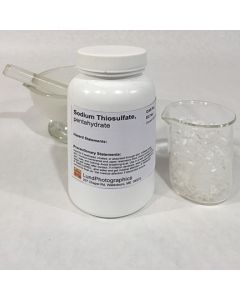Fixing Collodion Plates

Fixing Collodion Plates
After the plate is developed, you'll see a dark image on a milky background. This milky background is the remaining undeveloped silver halides. If not removed from the collodion, these halides will eventually darken, permanently staining, or even obliterating the original image.
These silver halides are not soluble in water. The function of the fixer is to combine with these silver halides making a water soluble compound that can then be rinsed out of the collodion with fresh water.
There are several chemicals available that will do this job. Hypo (sodium thiosulfate) , Potassium Cyanide, and Rapid Fix (ammonium thiosulfate) are some of the most commonly used. Fixing the plate can be done in either a tank or in a tray with equally effective results.
Once you place the plate in the fixing bath, you'll begin to see the milky background slowly dissolve away. The rate at which the milkiness disappears depends on the concentration and freshness of the fixing bath. A good rule of thumb for fixing time is to note how long it takes to clear the plate, then double it.
As you continue to use the fixing bath, it will eventually become saturated with dissolved halides and increasing the clearing time. Here’s a good rule of thumb for gauging when the fixer bath is exhausted and should be replaced: make note of the time it takes a plate to visually clear with a fresh bath. When the clearing time becomes approximately twice what it was for the fresh bath, you’re ready to mix up a new batch of fixer.
Wash the fixed plates in fresh running water for a minimum of 5 minutes to remove any chemistry that remains in the collodion film.

